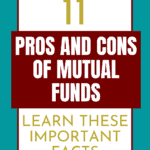THIS POST MAY CONTAIN AFFILIATE LINKS. PLEASE SEE MY DISCLOSURES. FOR MORE INFORMATION.
Mutual funds have a lot of positive things going for them.
But they also have some drawbacks.
And depending on who you ask, some will recommend these investments while others won’t.
So I put together this list of the biggest pros and cons of mutual funds.
You will learn the common reasons why people recommend or don’t recommend investing in a mutual fund and can make an informed decision as a result.
Table of Contents
11 Important Pros And Cons Of Mutual Funds
6 Pros Of Mutual Funds
Mutual funds are a great way to start investing in the stock market.
Here are the biggest advantages of mutual funds and why you should consider investing in them.
#1. Instant Diversification
One of the biggest mutual funds advantages is that you are instantly diversified.
Since a mutual fund is made up of thousands of stock holdings across all industries, you don’t have to worry about having all your eggs in one basket.
From the start, portfolio diversification is built into every mutual fund.
This helps to reduce both investment risk and market volatility.
- Read now: Learn how to navigate a volatile stock market
- Read now: Click here to learn all the investing risks
Some investment professionals even suggest that you can have a fully diversified mutual fund portfolio with just 3 funds.
This makes investing simple for any investor.
#2. Can Buy Fractional Shares
Another benefit of mutual funds is the ability to buy fractional shares.
When buying individual stocks, most brokers require that you buy whole shares, meaning you buy a whole number like 5, 50, 100, etc.
With mutual funds, you don’t have to do this.
You can instead focus on the amount of money you want to invest.
So if you want to invest $25, you invest this amount.
If the mutual fund is trading at $50 per share, you just bought 0.50 shares.
This allows for easier investing and for people without a large amount of money to invest.
#3. Invest A Small Amount Of Money
Speaking of money, you can buy mutual funds for as little as $1.00.
There are two requirements when investing in mutual funds.
- Initial investment
- Subsequent investment
The first is your initial investment, or the amount you invest to open your account.
This varies by investment company, but is anywhere from $1.00 up to $50 or more.
Then there is the subsequent or additional investment.
This is the money you want to keep investing in the future.
You can set up an automatic investment option or just randomly invest more money.
The requirement here is usually the same or less than the initial investment.
And some fund companies will lower this amount if you do set up an automatic investment.
If you aren’t sure if you should invest automatically, you should.
It will put investing your money and growing your wealth on autopilot.
At the end of the day, with low minimum investments, all investors can start to invest in most mutual funds when they have very little money.
#4. Invest In An Investment Strategy You Want
With thousands of mutual funds out there targeting all sectors of the stock market and various investment objectives, you can build an investment portfolio that works for you.
Maybe you want to invest in dividend paying stocks.
You can find mutual funds that do this.
Or maybe you want to invest in small company stocks.
You can do this as well.
Your options are close to endless with mutual funds.
You could invest based on market capitalization, like large company or small company, domestic or international companies, or even government bonds or municipal bonds.
Another option is by asset class, so you could invest in real estate as an example.
Or maybe you have no clue how to invest your money.
This is OK too, as you can invest in a target date fund.
- Read now: Learn more about target date funds
The bottom line is, no matter the strategy you want to follow, mutual funds make it possible.
#5. Professional Management
Another advantage of mutual funds is they are professionally managed.
This means a team of fund managers work together to select the stocks a mutual fund will invest in.
They continually monitor the fund’s performance and if they see better investing opportunities, they will sell some holdings to buy something else.
As a result, the fund’s portfolio is ever changing to keep up with what is happening in the stock market.
Note that a professional fund manager is buying and selling in active management funds only.
These are mutual funds whose goal is to outperform an underlying benchmark.
An index fund, or passive management, is only looking to keep pace with their benchmark and as a result, they won’t be buying or selling as frequently.
#6. Dividend Reinvestment
The final advantage of mutual funds is you can set up dividend reinvestment.
This simply means that every time you get paid a dividend, you can elect to have the money reinvest, buying more mutual fund shares.
Doing this will help you grow your investment since once you invest the dividends, now it too can start compounding and earning dividends as well.
You can do the same thing with capital gains too.
Simply choose to reinvest these and you will see the value of your mutual fund increase over time as well as the size of your dividends.
5 Cons Of Mutual Funds
As great as mutual funds are, there are some drawbacks to mutual funds.
Here are the biggest disadvantages of mutual funds you need to know.
#1. Large Number Of Mutual Funds To Choose From
A big downside to mutual funds is the sheer number of choices you have.
As of this writing, there are over 7,500 different types of mutual funds you can choose from.
Just seeing that number can deter many from even getting started with investing.
What makes things even trickier is that many funds are very similar to each other, they are just offered by different mutual fund companies.
In addition to this, you have active mutual funds and passive mutual funds.
The biggest difference here is that with active funds, the management team is actively trading while with passive funds, the fund manager is more hands off.
To help overcome this issue, stock with broad based funds that invest in underlying markets.
This will weed out the majority of mutual funds to choose from.
#2. Can Have Overlap Of Stocks
Continuing the point above, many mutual funds have an overlap of individual stocks.
For example, let’s say you are looking at growth funds and a large cap blended mutual fund.
The overall goal of these two funds is different.
The growth fund is investing in companies that are growing quickly whereas the blended fund is trying to find a balance between growing companies and mature companies that are growing more slowly.
They sound completely different.
But when you look at the individual stocks they own, you see that they both own the many of the same growth companies.
So while you think you are diversifying your investments, you are really adding to some of your holdings.
This can give a false sense of diversification or even worse, over-diversification.
#3. No Capital Gains Control
One major disadvantage of mutual funds is the lack of control over capital gains.
With individual stocks, you control when you sell your holdings, and as a result control when you realize capital gains that you must pay tax on.
Even with ETFs, you have some control over this.
But with mutual funds, you don’t have any control.
This tax inefficiency can cost you money over time.
So, you could invest in a mutual fund, not sell any shares and still owe tax on capital gains because the mutual fund had to sell shares.
For some high income investors, this is a big enough turnoff that they avoid mutual funds.
But for most other investors, this isn’t a huge deal.
And since the IRS taxes capital gains at a different rate, the taxes owed are usually small.
#4. High Fees
Mutual funds can cost you a lot of money.
They have all sorts of fees related to them, including the management fee, 12-b1 fee, redemption fees, sales charges, and purchase fees in the form of a load.
- Read now: Here are the investing terms you need to know
- Read now: Learn how investment fees eat away at your wealth
An in addition to these fees, all mutual funds charge a different expense ratio.
For actively managed funds, you can expect to pay an average annual fee of 1% for stock mutual funds and close to 1% on bond funds.
Understand you pay these fees regardless of the fund’s performance.
Luckily, there are ways around many of these fees.
You just have to do a little research and look for index funds, or passively managed funds.
- Read now: Learn the pros and cons of index funds
Passive index funds track the stock market and not only avoid the majority of fees, but charge the lowest fees.
This is because the fund management team isn’t doing a lot of work picking stocks.
They are simply tracking a benchmark index.
All of these fees eat away at the returns of your money.
And over time, they can have a tremendous negative impact on how much money you end up with.
Especially if you invest in a mutual fund with higher management fees.
When you do this, more of your money is going to pay the fees than is staying invested.
With less money invested, it will compound and grow less over the years, resulting is a smaller ending balance.
#5. No Real Time Trading
The final downside of mutual funds is there is no real time trading.
While you can buy or sell a stock or exchange traded funds (ETF) anytime the market is open and get that price, with mutual funds, you have to wait until the end of the day.
If you put in an order to sell at 11am, your trade will be completed at the end of the day.
Of if you put in a buy order at 2pm, it will be completed at the end of the day.
Some see this as a good thing as it limits investors trading irrationally, based on emotion.
- Read now: See why you are your greatest enemy when investing
- Read now: Click here for the best Jack Bogle quotes
But others see this as a drawback as you can’t get the absolute best price based on what the stock market is doing.
This shouldn’t be a major issue for the average investor investing for the long term.
Final Thoughts
At the end of the day, those are the biggest pros and cons of mutual funds.
While there are downsides, I feel that many investors would benefit to invest in mutual funds.
You don’t need a lot of money, and if you set up a recurring investment, you can let your money work for you without having to lift a finger.
And this can pay off nicely in the future.
- Read now: Learn the investing basics you need to know
- Read now: Discover your ideal risk tolerance
- Read now: Here is how to invest when you are scared of the stock market
I have over 15 years experience in the financial services industry and 20 years investing in the stock market. I have both my undergrad and graduate degrees in Finance, and am FINRA Series 65 licensed and have a Certificate in Financial Planning.
Visit my About Me page to learn more about me and why I am your trusted personal finance expert.




